To embed circular principles in workshops, focus on designing activities that emphasize resource efficiency, lifecycle thinking, and sustainable materials. Incorporate hands-on exercises with recycled or biodegradable resources, promote collaboration, and encourage reflection on impact. Use real-world case studies to inspire change and address challenges like resistance or resource constraints. By fostering a culture of sustainability, you guarantee long-term positive habits. Exploring these strategies further helps you create meaningful, eco-conscious workshops that inspire ongoing commitment.
Key Takeaways
- Incorporate lifecycle assessment early in workshop design to identify and minimize environmental impacts.
- Use recycled, biodegradable, and durable materials to promote resource efficiency and circularity.
- Foster participant engagement through collaborative activities and reflection to reinforce sustainable practices.
- Share success stories and practical analogies to demonstrate the benefits of circular principles in resource management.
- Embed sustainability practices into organizational culture through leadership, ongoing actions, and continuous improvement.
Understanding Circular Economy Foundations
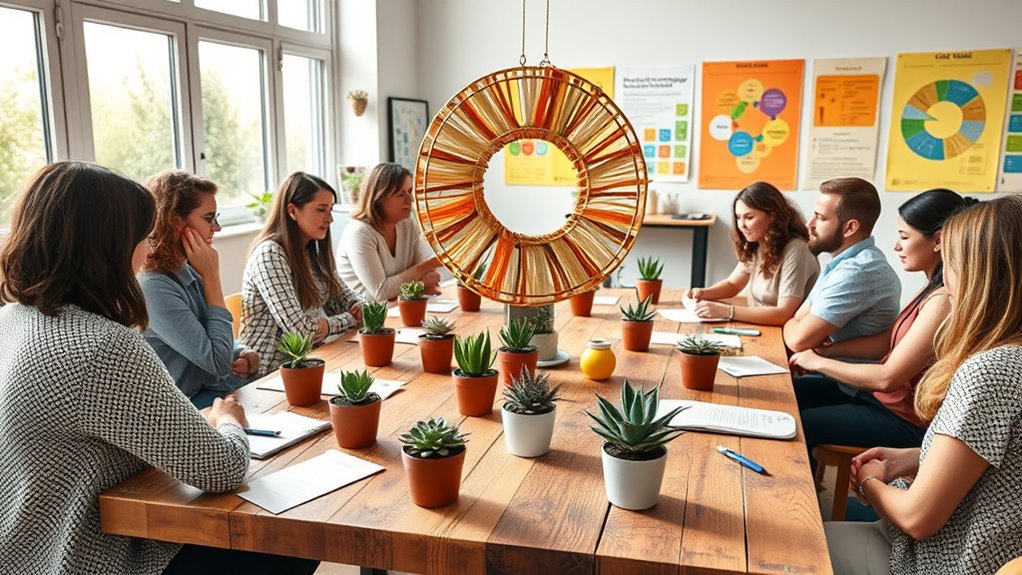
Have you ever wondered how we can reduce waste and make better use of resources? The answer lies in understanding the principles of a circular economy. This approach emphasizes resource efficiency by keeping materials in use for as long as possible, maximizing their lifespan. Instead of following a linear model—take, make, dispose—a circular economy encourages designing products that can be reused, repaired, or recycled. By doing so, you extend the material lifespan and reduce the need for virgin resources. Regular maintenance and proper disposal methods are essential for supporting wood stove safety and sustainable resource management. This shift not only minimizes environmental impact but also creates economic opportunities. Grasping these foundational ideas helps you see how sustainable practices can be integrated into daily operations, fostering innovation and resilience in resource management.
Designing Workshop Activities With Sustainability in Mind
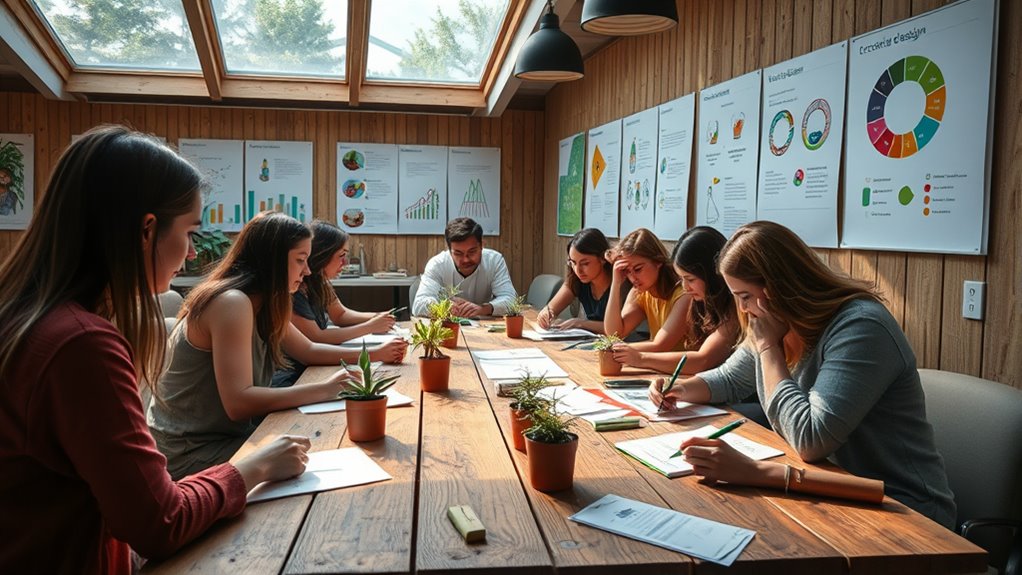
When designing workshop activities with sustainability in mind, you can actively influence participants’ understanding and commitment to eco-friendly practices. Incorporate discussions about eco friendly packaging, emphasizing reusable or biodegradable options to reduce waste. Encourage participants to contemplate how packaging impacts the environment and explore alternatives that align with circular principles. Additionally, highlight the importance of using renewable energy sources during activities, such as solar or wind power, to demonstrate practical ways to reduce carbon footprints. Incorporate hands-on exercises that showcase energy-efficient solutions and sustainable resource management. Highlighting the role of sound design techniques in creating immersive and environmentally conscious audio experiences can further reinforce sustainable practices. By embedding these topics into your activities, you help participants see the tangible benefits of eco-conscious choices and inspire them to adopt sustainable habits beyond the workshop.
Selecting Materials and Resources for Longevity and Recyclability
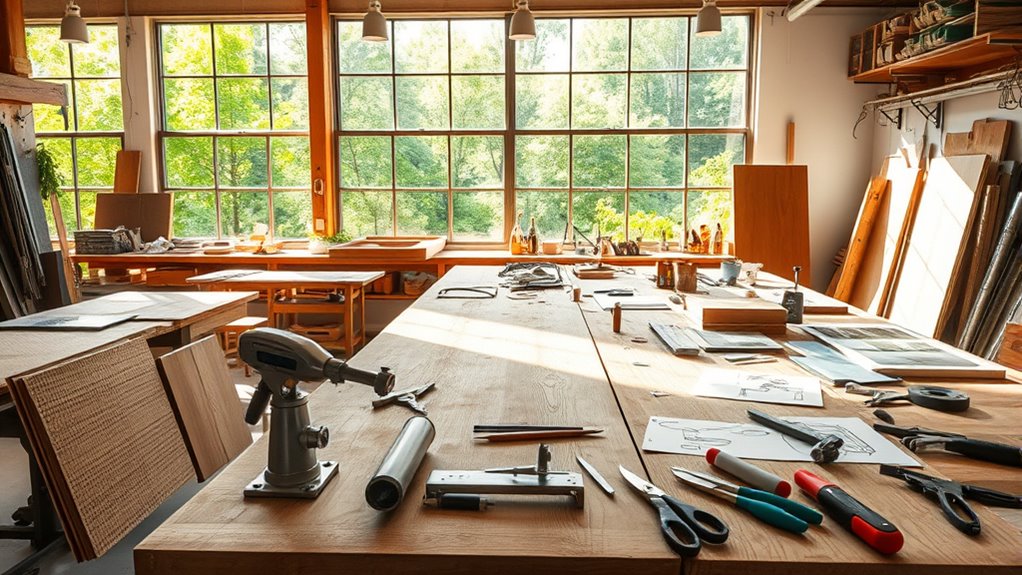
How can you guarantee that the materials and resources you choose support sustainability over time? Focus on selecting biodegradable materials that naturally break down, reducing environmental impact. Prioritize resources with strong recyclability considerations, ensuring they can be reused or repurposed easily. Look for options made from renewable or recycled content, which extend their lifecycle and minimize waste. Avoid single-use or non-recyclable items that contribute to landfill accumulation. When evaluating materials, consider their durability and potential for multiple uses, which enhances longevity. Incorporate labels or certifications indicating eco-friendly properties to make informed choices. Additionally, selecting glamping-friendly materials that are designed for outdoor use can ensure durability and resistance to weather conditions. By consciously choosing materials aligned with these principles, you’ll foster sustainable workshop practices that support environmental health and circular economy goals.
Incorporating Lifecycle Thinking Into Creative Processes
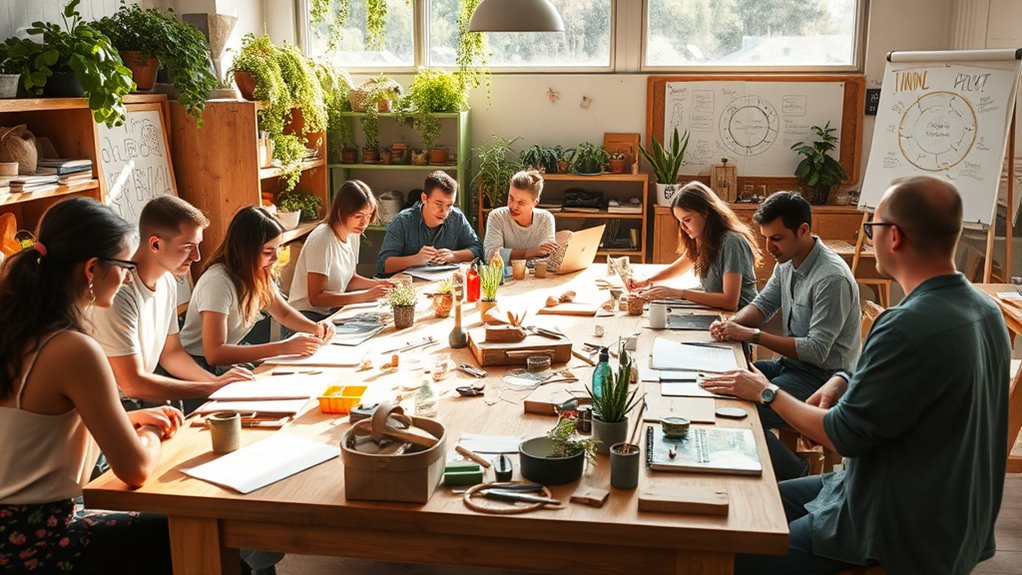
Integrating lifecycle thinking into your creative processes means intentionally considering a product’s environmental impact from conception to disposal. Start by evaluating materials through material innovation, seeking options that reduce environmental harm and enhance recyclability. Incorporate lifecycle assessment early to identify stages where environmental impacts are highest, guiding design adjustments. This approach encourages you to select sustainable materials, optimize resource use, and design for durability and disassembly. By embedding these practices, you ensure your projects align with circular principles, minimizing waste and extending product lifespan. Lifecycle thinking transforms your creative process into a proactive effort to reduce ecological footprints, fostering innovation that balances functionality with sustainability. Additionally, exploring eco-friendly accommodations can inspire sustainable design choices for eco-conscious projects. Ultimately, this mindset helps you create designs that are both inspiring and environmentally responsible.
Engaging Participants in Circular Design Thinking

To effectively engage participants in circular design thinking, you should incorporate interactive brainstorming techniques that encourage open idea sharing. Hands-on prototype activities allow participants to test concepts and see sustainability in action. Collaborative reflection strategies help everyone learn from experiences and refine their approaches for better results. Incorporating projector technology can also facilitate visual presentations and collaborative discussions during workshops.
Interactive Brainstorming Techniques
Ever wondered how to make brainstorming sessions more dynamic and effective? One powerful technique is using mind mapping to visualize ideas and see connections clearly. As participants share suggestions, encourage idea clustering—group related concepts together to identify patterns and priorities. This approach keeps everyone engaged and helps surface innovative solutions aligned with circular principles. By visually organizing thoughts, you create a collaborative environment where ideas evolve organically. Incorporate color coding or symbols to differentiate themes, making it easier to spot opportunities for reuse, recycling, or redesign. Interactive brainstorming with mind mapping and idea clustering not only sparks creativity but also deepens understanding of circular design thinking. Additionally, understanding cybersecurity vulnerabilities, such as those exploited during the recent Microsoft Outage Impact, can inform more resilient and secure workshop practices. It transforms passive discussion into a strategic, engaging process that drives sustainable innovation.
Hands-On Prototype Activities
How can you bring circular design thinking to life? One effective way is through hands-on prototype activities that emphasize material reuse and lifecycle analysis. Encourage participants to create models or mock-ups using recycled or repurposed materials, highlighting how products can be designed for longevity and easy material recovery. Integrate lifecycle analysis into the process by prompting participants to contemplate each stage of a product’s life—from raw material extraction to disposal—and how design choices impact sustainability. These activities help participants grasp the practical aspects of circularity, fostering innovative solutions that minimize waste. Incorporating vertical storage solutions and multi-functional furniture into the activities can further demonstrate space-efficient, sustainable design strategies. By physically engaging with materials and thinking critically about their lifecycle, participants develop a deeper understanding of how circular principles translate into real-world design strategies.
Collaborative Reflection Strategies
Engaging participants in circular design thinking benefits greatly from collaborative reflection strategies that foster shared insights and collective problem-solving. By encouraging peer collaboration, you create a space where everyone can openly share ideas and build on each other’s perspectives. Reflection sessions, such as group discussions or feedback rounds, help participants identify what works and what needs improvement within circular approaches. These strategies promote active listening and mutual learning, reinforcing a sense of collective ownership over the design process. When participants feel heard and valued, they’re more likely to contribute innovative ideas and challenge assumptions. Incorporating group dynamics into the process can further enhance engagement and collaboration. Ultimately, collaborative reflection deepens understanding, accelerates learning, and enhances the integration of circular principles throughout the workshop.
Case Studies: Successful Integration of Circular Principles
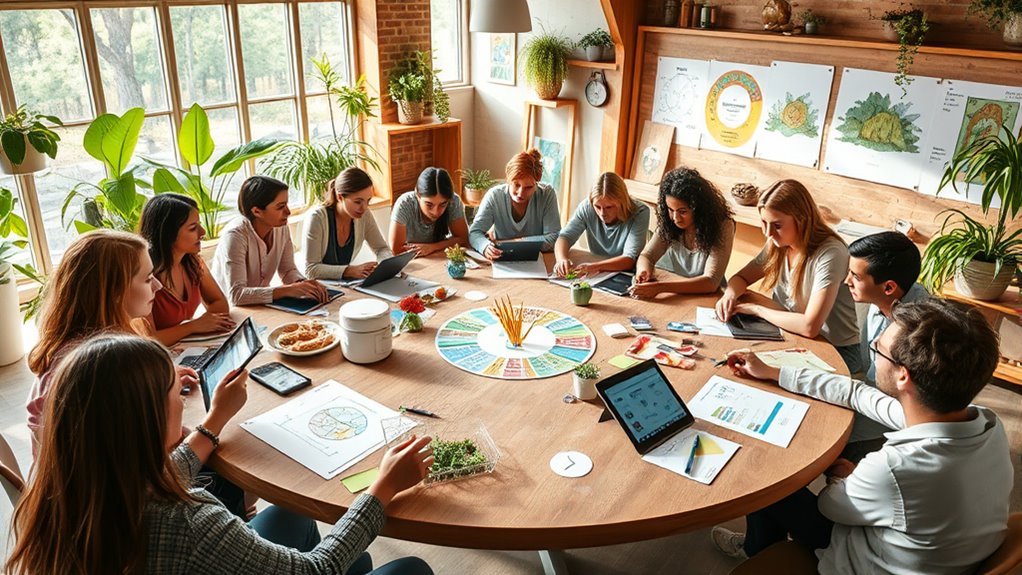
Have you noticed how some companies seamlessly incorporate circular principles into their operations? They use upcycling art to transform waste into creative products, showcasing innovative design while reducing landfill waste. For example, brands have embraced eco-friendly packaging made from recycled materials, cutting down on single-use plastics and minimizing their environmental footprint. These companies prioritize sustainability by design, demonstrating that circular principles aren’t just theoretical but practical. They engage in closed-loop systems, ensuring materials are reused and repurposed effectively. By integrating these strategies into their workflows, they set a standard for responsible business practices. Their success stories serve as inspiring examples, proving that embedding circular principles can boost brand reputation and help achieve genuine sustainability goals. Additionally, highlighting leadership skills within these initiatives encourages a strategic approach to sustainability, fostering a culture of continuous improvement and innovation.
Overcoming Challenges in Implementing Circular Strategies
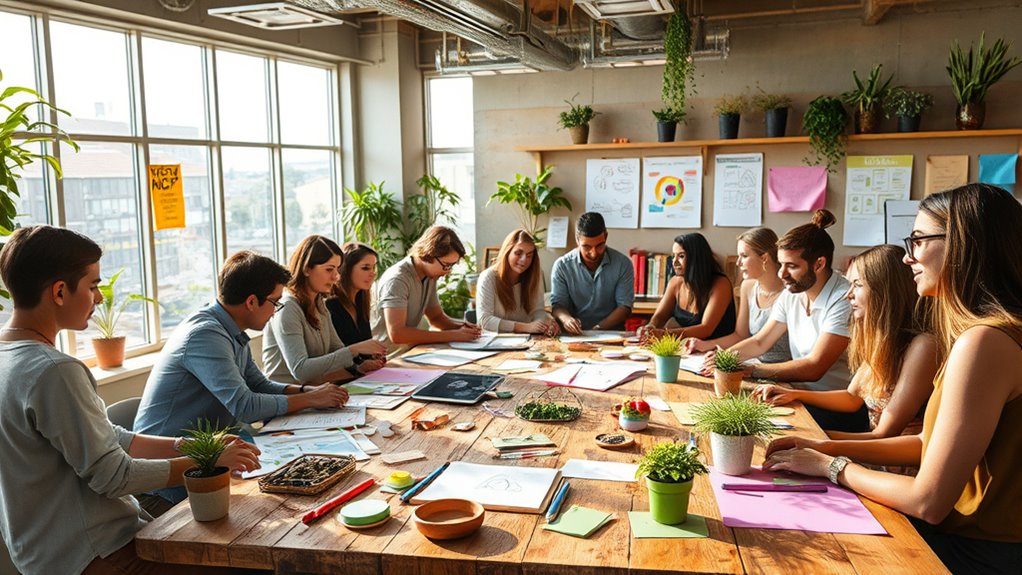
What obstacles stand in the way of successfully implementing circular strategies, and how can organizations overcome them? Cultural barriers often hinder change, as staff may resist new approaches or fear job security shifts. To address this, you need clear communication, involving everyone in the transition, and demonstrating long-term benefits. Resource constraints also pose a challenge, limiting investment in new infrastructure or training. You can overcome this by prioritizing initiatives with quick wins and leveraging existing assets more effectively. Building a strong case for sustainability and fostering a mindset of continuous improvement helps break down resistance. By actively engaging your team and managing limited resources strategically, you pave the way for smoother adoption of circular principles and sustainable growth. Understanding self watering plant pots and their efficient water management can serve as a practical analogy for resource efficiency in circular strategies.
Measuring Impact and Success in Circular Workshops
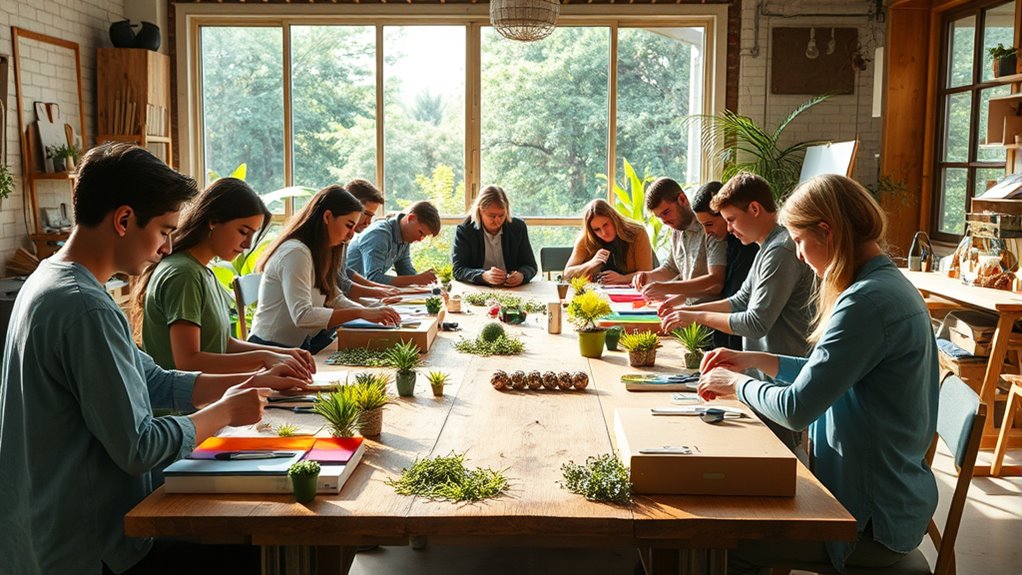
How do you effectively measure the impact and success of circular workshops? Start by identifying clear success indicators, such as participant engagement, knowledge retention, and the integration of circular principles into workflows. Use measurement techniques like surveys, feedback forms, and observation to gather tangible data. Tracking changes in resource usage, waste reduction, and process improvements can also indicate progress. Quantitative metrics provide concrete evidence of outcomes, while qualitative feedback highlights participants’ understanding and commitment. Regularly analyzing these indicators ensures you can assess whether your workshop achieved its sustainability goals. Remember, success isn’t just about immediate results but also long-term adoption of circular practices. Combining multiple measurement techniques gives you a thorough view of your workshop’s impact and guides future improvements.
Building a Culture of Sustainability Beyond the Workshop
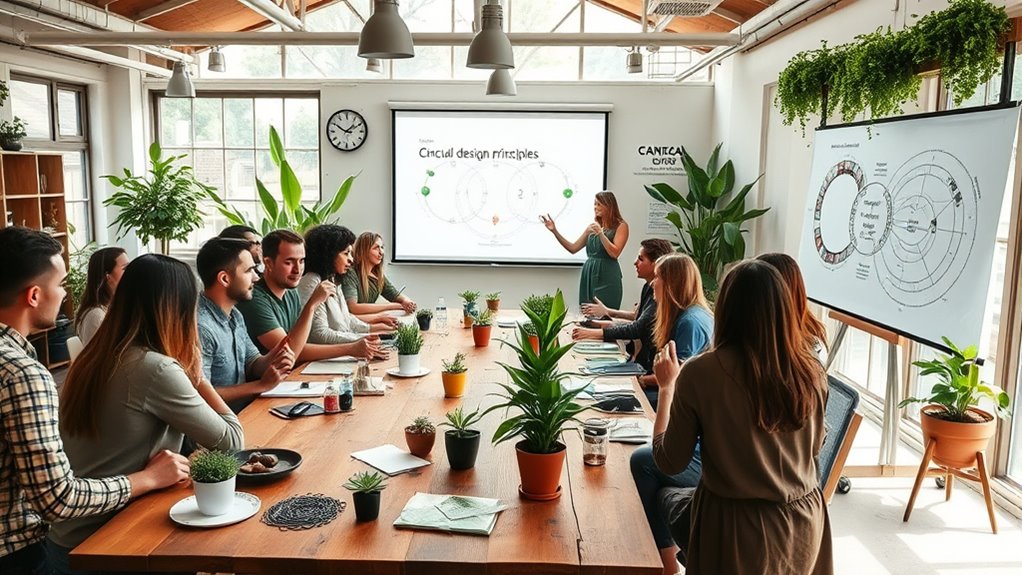
You can foster a lasting sustainability culture by cultivating mindsets that prioritize environmental responsibility every day. Embedding simple practices into your routine helps make sustainability a natural part of your organization’s identity. Leadership plays a pivotal role in reinforcing these values and inspiring others to follow suit.
Cultivating Sustainability Mindsets
Building a culture of sustainability requires more than just attending workshops; it demands cultivating the right mindsets that become part of daily routines. You can start by embracing eco-friendly packaging options, making conscious choices that reduce waste and promote reuse. Encouraging team members to pursue green certification demonstrates a commitment to sustainable practices, reinforcing the importance of continuous improvement. When sustainability becomes a core value, it influences decision-making and shapes behaviors beyond formal training. This mindset shift fosters innovation and accountability, ensuring sustainability principles are embedded in everyday activities. By actively promoting these attitudes, you nurture a culture where sustainability is second nature, helping your organization move toward more circular, environmentally responsible operations.
Embedding Practices Daily
Once the initial training is complete, integrating sustainability practices into daily routines becomes essential for maintaining momentum. Consistently practicing these habits helps reinforce your commitment and embeds circular principles into your work culture. Focus on small, manageable actions—such as mindful resource use or waste reduction—that you can perform daily. Over time, these actions become habits, making sustainable choices automatic rather than forced. Encourage your team to share their progress and challenges, fostering a culture where sustainability is part of everyday decision-making. By consciously embedding these practices into your routines, you create a lasting shift that extends beyond workshops. Habit formation is key; it transforms initial learning into sustained, meaningful change.
Leadership’s Role in Culture
Leadership plays a crucial role in shaping and sustaining a culture of sustainability beyond the initial training sessions. Your commitment sets the tone for corporate accountability, making it clear that sustainability isn’t a passing trend but a core value. Ethical leadership involves consistently demonstrating responsible decision-making and inspiring others to follow suit. By embedding sustainability into daily operations, you reinforce its importance and encourage your team to prioritize circular principles. Your actions influence organizational norms and motivate employees to adopt sustainable practices naturally. When leaders visibly champion sustainability, it fosters trust and accountability throughout the company. Ultimately, your leadership creates a lasting culture where sustainability becomes ingrained, empowering everyone to contribute to long-term environmental and social responsibility.
Frequently Asked Questions
How Can Workshops Promote Long-Term Circular Mindset Shifts Among Participants?
You can promote long-term circular mindset shifts through workshops by encouraging behavior change and fostering stakeholder engagement. Use interactive activities that challenge existing assumptions, making participants see the benefits of circular principles. Facilitate open dialogue to build buy-in and create shared goals. Consistently reinforce key concepts and provide practical tools, ensuring participants leave motivated and equipped to implement sustainable practices, leading to lasting behavioral transformation.
What Are Innovative Ways to Teach Circular Economy Concepts Creatively?
Think of teaching circular economy concepts as planting seeds for future change. You can make it lively by using interactive storytelling to engage participants’ imaginations and hands-on prototyping to turn ideas into reality. This creative approach helps people see the real-world impact of circular principles, making complex ideas tangible and memorable. By blending stories with tangible prototypes, you foster deeper understanding and inspire innovative thinking that sticks long after the workshop ends.
How Do Cultural Differences Influence Circular Design Workshop Approaches?
You should recognize that cultural differences shape how people approach circular design workshops. Cross-cultural communication influences participation, understanding, and collaboration, so adapt your methods accordingly. Incorporate traditional design methods from different cultures to foster inclusivity and respect diverse perspectives. By doing so, you create a more engaging, effective workshop environment where everyone feels valued and motivated to contribute to circular solutions.
What Funding Opportunities Support Sustainable Workshop Initiatives?
Think of funding opportunities as a fertile garden waiting for your seeds of innovation. You can explore grant opportunities from government agencies, environmental organizations, and private foundations focused on sustainability. Funding strategies involve crafting compelling proposals that highlight your workshop’s impact on circular principles. By nurturing these ideas with the right resources, you’ll cultivate sustainable initiatives that grow and flourish, transforming your vision into a thriving, circular future.
How Can Virtual Workshops Effectively Incorporate Circular Principles?
You can effectively incorporate circular principles into virtual workshops by leveraging digital collaboration tools that promote resource sharing and reuse. Use gamification techniques to engage participants and reinforce the importance of sustainability, encouraging innovative thinking around circular economy concepts. These strategies foster active participation, making it easier to embed circular principles into the workshop content, ultimately leading to more sustainable practices that resonate beyond the virtual environment.
Conclusion
As you finish your workshop, picture a ripple spreading outward, transforming mindsets and inspiring sustainable choices. By embedding circular principles, you’re planting seeds of change that grow beyond the room—materials reused, ideas reborn, and a greener future taking shape. Keep nurturing this cycle, knowing each small step contributes to a world where sustainability is woven into every design and decision. Together, you’re shaping a vibrant, regenerative tomorrow—one thoughtful workshop at a time.









